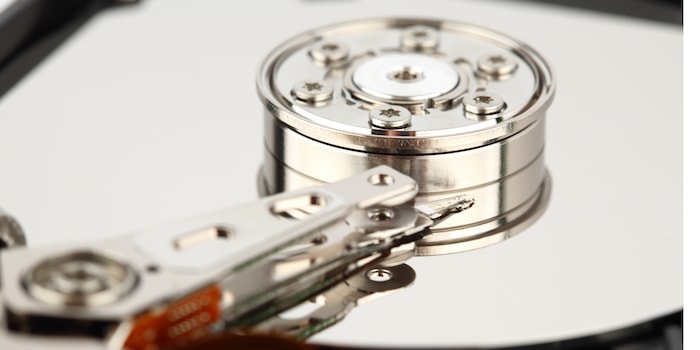
A question of size: the history of the hard disk
When it comes to IT, data storage is of paramount importance. In everyday life, this is often forgotten because it goes without saying. However, the hard disk has revolutionised the way computers are used: let's take a look at the history of punched cards, platters and many other formats.
As a child in the 80s and 90s, I can still hear in my head the characteristic sizzling sounds of the hard drive booting up, something that today's PCs and laptops with SSDs no longer do. Back then, they were a cacophony; today, listening to them, you immediately fall back into childhood. And in a way, they were reassuring, because I knew then that things were running. But with an SSD, I no longer have that pleasure.
In my day-to-day work, I'd almost forget the existence of my laptop's hard drive. Mass storage paved the way for the PC. Before its advent, data was mainly stored on punched cards, invented by the American Herman Hollerith.
Conquering the world with holes
Herman Hollerith was working on the tabulation of the 1880 census, during which he was confronted with the problem of how to use the data. The mechanical auxiliary devices of the time were reaching their limits because of the enormous amount of paper generated. It would take eight years before all the results were available. To meet this daunting challenge, he developed a system of punched cards, for which he filed a patent in 1889.
Did you know that this type of punched card system already existed before Hollerith? But his, originally designed to store data, consisted of a perforator, a reader with tabulator and a sorter. The first punches the data onto the card. The second scans the punched card and transmits the data to the tabulator counters by means of electrical impulses. The sorter forms stacks according to certain criteria. The Hollerith machine can be programmed to a limited extent with interchangeable frames. Using this process, the processing of the card contents could be defined on the tabulator.
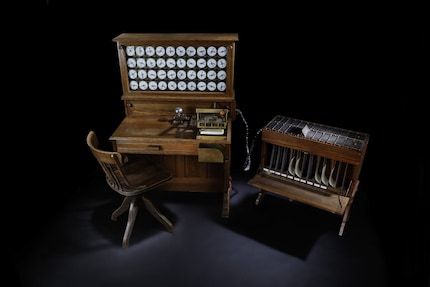
Source: Heinz Nixdorf MuseumsForum (HNF)
Thanks to the Hollerith system, the 1890 census took slightly less time. After three months, the first data could already be presented and, six months later, the count could be completed. After completing his studies as a mining engineer, he founded his own company, which was later bought out and then renamed IBM.
In 1928, the punched card adopted a standardised format. Here's roughly how it worked: on this card, holes are punched that represent coded characters. It has only a certain number of characters. Several cards are therefore needed for larger data/applications. These more modern punched cards have a capacity of 80 bytes.
Early HDDs
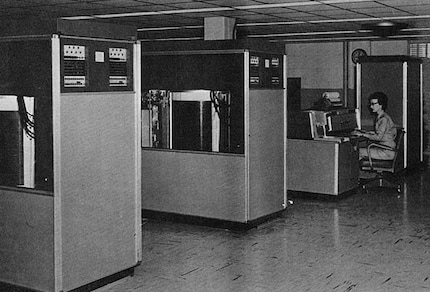
Source: Wikipedia
As the punched card system reached its limits, a new mass storage solution had to be found. This was when the hard disk made its appearance. In 1956, IBM launched the 305 RAMAC: this machine contained a hard disk with a capacity of 5 MB, using 50 platters 24 inches in diameter that could be magnetised on both sides. It took up a lot of space: weighing around one tonne, it measured 1.70 m x 1.50 m x 75 cm. Faced with such dimensions, trucks and trolleys have to be used to deliver the hard drives.
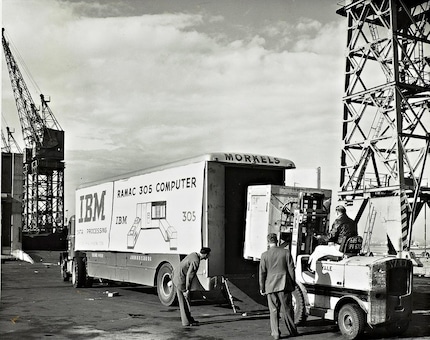
The mode of function of the first disc is already similar to that of today. Covered on both sides with a magnetic layer, the aluminium platters, rotating at 1200 rpm, were stacked one on top of the other, leaving a gap of eight millimetres. This machine is equipped with two read-write arms; the first, to select the tray, and the second, to position itself on the correct sector.
Advances
The IBM 1301 represents a large-scale successive milestone. The 1961 model had a read-write head for each of the 25 platters, which rotated at 1800 rpm. With 26,000 bytes per inch, it offered 13 times the memory capacity of the RAMAC. A year later, the 1311, the successor to the IBM 1301, hit the market. Its mass memory became somewhat mobile: the six 14-inch platters could be replaced. A stack of trays, weighing just 4.5kg, offers storage capacity for 2.6MB of data.
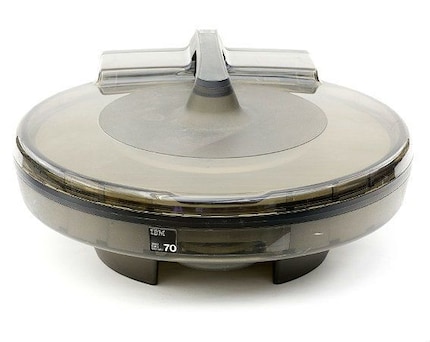
Source: computerhistory.org
Thanks to the IBM 3340 storage system, renamed "Winchester", various innovations were then introduced. To this day, all sealed-case disk drives - drives whose mechanics are protected from environmental influences - are so designated. The origin of this name, which is not well known, comes from a rifle model, the Winchester 30-30, which recalls the partitioning of memory into 30 MB and 30 MB (although this is not correct). Another possible reason? This disc was produced in Winchester. The platters are installed in removable modules. The read/write heads are fixed and therefore smaller and lighter than their predecessors. This technology enables a massive increase in storage capacity, as head adjustment tolerances between discs and different modules are eliminated. Memory capacity was 35 MB or 70 MB, depending on the module. In 1980, IBM reached a storage capacity of 2.52 GB for its systems.
Mass storage for PCs and laptops
Until the 1970s, computers were huge devices used mainly in businesses, universities and other institutions. But over the years, the price of electronic components fell, opening the way to new sales markets. Computers are also increasingly used in the private sector. The ability to store data on a medium was behind this development. Seagate, a young start-up at the time, made an enormous contribution. It developed a 5.25-inch hard disk with a storage capacity of 5 MB, for the modest sum of 1,500 dollars at the time. The Seagate ST-506 stores the operating system, software and data on a single medium. So it's no longer necessary to insert a floppy disk for each of these tasks.
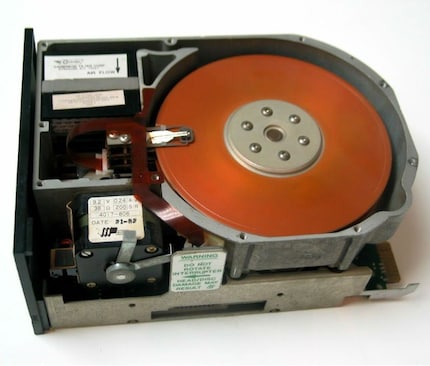
Source: computerhistory.org
Thereafter, storage capacity increased and hard drives shrank. In 1991, Toshiba launched a 2.5-inch hard drive. Today, they are mainly found at 3.5 or 2.5 inches. At first glance, it's mainly the interfaces that change: IDE, SCSI, ATA, SATA, PCIe. With each new interface, data transfer is faster and more reliable. As platter speeds increase, so does performance. Storage capacity is boosted by, among other things, a greater number of platters in the same space (glass-ceramic platter instead of aluminium platter, thinner design possible) and a new writing process: initially Longitudinal Recording (LTR), then Perpendicular Magnetic Recording (PMR) and finally Shingled Magnetic Recording (SMR). Thanks to SMR technology and filling with helium instead of air, it is currently possible to manufacture 14TB hard drives.
HDD vs SSD
The demise of hard drives has been decried ever since SSDs with more reasonable memory capacity became affordable. Although SSD technology is almost as old as HD, it only became a cost-effective competitor with the advent of flash SSDs. Right now, HDDs offer more storage for less money. However, SSDs already have more storage capacity. Soon, 100TB models will be on the market. For the average consumer, however, they are likely to remain unaffordable for some time (with prices in the five-figure range). The ever-increasing storage capacity of SSDs will further reduce their price. The price gap per GB between HDD and SSD will narrow more and more in the future.
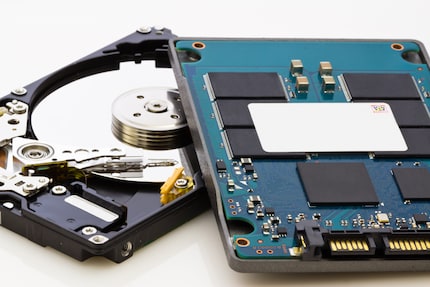
As HDDs offer more storage capacity for the expense incurred, they are currently much better suited to servers/NAS. NAS network storage depends mainly on the speed of the connection technology. In a 1 Gbit network, the speed of an SSD is lost during transmission. You would need a 10 Gbit network for an SSD on NAS to make sense.
The future of the hard drive
Memory requirements are currently so great that they cannot be met by SSDs alone. In seven years, only ten per cent of global demand will be covered by flash memory. Hard disks will still be used, but their storage capacity will have to be increased. To do this, we can resort to a simple method: taller enclosures capable of holding more of them. In addition to this relatively simple increase in capacity, research is also being carried out into new hard drive technologies.
Two of these promising technologies are on the way to market: Western Digital is working on MAMR and Seagate on HAMR.Heat Assisted Magnetic Recording technology involves using a thermal laser that briefly heats the magnetic substrate to be written to. Once this operation has been completed, the temperature returns to normal. Thanks to this heating technique, writing requires a lower field intensity. As a result, the heads are a little thinner, as are the tracks: in other words, there is more room to write in the same space. Microwave Assisted Magnetic Recording goes in the same direction. This technology uses a print head equipped with a microwave transmitter. It requires less magnetic field intensity to magnetise the substrate.
The new technologies should make it possible to create 100TB hard disks. According to current forecasts, they should arrive by 2025. The hard disk still has a bright future ahead of it, at least as long as HDDs offer more capacity and are cheaper than SSDs.
From big data to big brother, Cyborgs to Sci-Fi. All aspects of technology and society fascinate me.
Interesting facts about products, behind-the-scenes looks at manufacturers and deep-dives on interesting people.
Show all